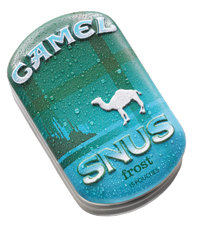R.J. Reynolds Creates New Product Supply Chain
 The economic fallout of 2008 has given many consumer goods executives reason for concern. Still, economic issues are just the tip of the iceberg for R.J. Reynolds Tobacco Co. The No. 2 cigarette manufacturer in the United States has been facing an industry-wide decline due to changing consumer tastes and increasing legislation against smoking. Couple this with an imminent 150 percent increase in federal excise tax, and new sources of growth become a clear priority.
The economic fallout of 2008 has given many consumer goods executives reason for concern. Still, economic issues are just the tip of the iceberg for R.J. Reynolds Tobacco Co. The No. 2 cigarette manufacturer in the United States has been facing an industry-wide decline due to changing consumer tastes and increasing legislation against smoking. Couple this with an imminent 150 percent increase in federal excise tax, and new sources of growth become a clear priority. To offset impending challenges, management opted to invest aggressively in new and innovative product categories. The move to a Total Tobacco Strategy, anchored with the introduction of modern, smoke-free tobacco (MSFT) products, positions Reynolds in a growing segment of the tobacco industry. MSFT products, like Camel SNUS and Camel Orbs (a dissolvable tobacco product) provide adult tobacco consumers a convenient alternative to enjoy tobacco in places, and at times where they cannot smoke.
Uncertain Demand
Management understood that executing against this strategy would require every function to move beyond a business as usual approach. Clarkston Consulting was engaged to align the supply chain with the company's new product strategy without disrupting the economies of the current cigarette supply.
"Clarkston Consulting's depth of experience in the consumer products industry and the relevance of their strategic approach to our challenges made them the perfect partner for this initiative," says Tim Martin, vice president, Supply Chain Management, R.J. Reynolds.
New-to-world products represent a major game-changer for Reynolds operationally. Cigarette consumers are known to be brand loyal, resulting in predictable demand and long product life cycles. Reynolds has become very proficient at getting cigarettes to market, with enviable distribution costs. The distribution characteristics of these new products, however, imply a different supply challenge. The very newness of MSFT products means demand will be inherently unpredictable, with varying life cycles depending on how the products are received.
Uncertainty about how the market will respond amplifies the risks of both over-selling and under-selling the plan. Neither alternative is acceptable. The cost of a lost sale due to an out of stock at retail is much higher during product introduction. On the other hand, the product churn often associated with new-to-world products creates a high risk of obsolescence. The tenets of new product supply are different than those of cigarettes -- responsive supply with high service levels versus efficient distribution with fast inventory turns. Clarkston proposed a segmented supply chain tailored specifically to MSFT products, which would facilitate growth.
Ensuring Agility
The "agile supply chain" must assess early sales or other market signals and respond through mid-period adjustments within the context of Reynolds' monthly S&OP process. Reynolds has invested in syndicated point-of-sale data to gain the most forward visibility possible for the fragmented convenience/gas distribution channel. This data acts as a "listening post" tuned into consumer demand. Reynolds is establishing an analytical framework to frequently assess planning assumptions and then make short-term changes in supply plans like deployment. The framework places as much emphasis on retail execution as supply planning. If one chain is selling significantly more than a competitor, or if there are compliance issues at retail, Reynolds must address that opportunity in a timely manner.
"The creation of a segmented supply chain which is responsive to consumer demand represents a step change for R.J. Reynolds," says Rick S. Baker, vice president Trade Marketing Development, R.J. Reynolds Tobacco Co. "Supply chain innovation is necessary to support the level of product innovation our business dictates."
Choosing to Outsource
Reynolds chose to outsource the logistics execution of the agile supply chain to OHL, a third-party provider, and use contract manufacturers for production where appropriate. Outsourcing provides Reynolds with the flexibility to scale supply as demand grows while making operating costs variable. The outsourcing model also reduces organizational complexity in a way that could not be achieved with a conventional cigarette supply chain.
The agile supply chain represents an investment in growth. Its primary function is to match supply with uncertain demand for new products with less focus on achieving the lowest possible unit cost. With the help of Clarkston Consulting, Reynolds was able to go from concept to shipping out of two green field warehouses within 12 months to support the national rollout of Camel SNUS.
